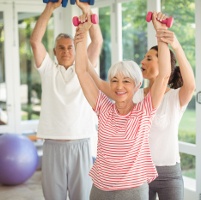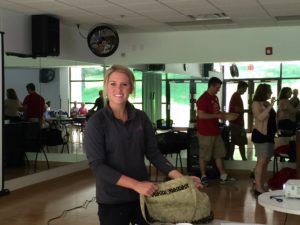
Summer is the perfect time to get active. Maintaining a consistent level of physical activity actually helps seniors stay pain-free, reduce the risk of falls, stay independent longer and increase well-being. Staying fit has more health benefits than just physical. According to a new study from Boston University Medical Center, fit older adults showed increased brain activity patterns in regions of the brain associated with typical age-related decline.
Exercise and staying fit is an ageless opportunity and you can start at any age. You just need to get up and get going. As with any exercise, sedentary or inactive people should start slowly and gradually advance the intensity of their training regimen. Additionally, speak with your home care provider or physician to make sure you are ready to start. Regardless of the activity, the point is – get active by incorporating activities that spark your purpose and passion.
Jenny Vlasak, Medical Communication Specialist for Lifesprk and ACE Certified Personal Trainer and certified Yoga Instructor shares tips on improving balance, flexibility, endurance and strength specifically for seniors to spark their summer and beyond.
- Balance: Good balance is key to preventing falls and avoiding the disability that may result from falling. Make sure you have a sturdy chair and supportive shoes. Try standing on one foot, then the other. If you can, don’t hold on to anything for support – make sure you have someone standing by the first time you attempt this. Get up from a chair without using your hands or arms. Every now and then walk heel-to-toe. As you walk, put the heel of one foot just in front of the toes of your other foot. Your heel and toes should touch or almost touch.
- Flexibility: Stretching improves flexibility to give you more freedom of movement for routine tasks such as walking, tying your shoes, swimming in a pool, walking around campus, or pulling a sweater over your head. Try yoga, Pilates, or talk with our Navigation Desk (952-345-0919) for local resources to help with stretching techniques.
- Cardiovascular/Endurance: Endurance activities build your energy or “staying power.” Try to work up to at least 30 minutes of activity every day, even ten minutes at a time is fine. The goal: do an activity that makes you breathe hard each time you do it. Try walking, swimming or water aerobics. Remember, if you can talk without any trouble at all, you are not working hard enough. If you can’t talk at all, it’s too hard.
- Strength: Slowly introduce light strength training activities, do these a few times each week adding exercises designed to build stronger muscles like weight lifting, resistance exercises, and weight machines. The goal? Stronger muscles help you get up from a chair by yourself, lift your grandchildren, take walks through the park, and prevent falls. (You are less likely to fall when your leg and hip muscles are strong.) And according to an article in Next Avenue, numerous studies show positive changes from a well-designed strength routine even in seniors over 90-years-old. Improvements can be seen in gait speed, stair climbing ability, balance and overall functioning – lower extremity muscles are most important to strengthen, particularly the quadriceps — the large muscle in front of the thighs responsible for extending the knee.
We’d love to hear from you – what are your plans this summer to get moving? Share with us stories of how balance, flexibility, endurance or strength training has changed your or your elderly loved one’s ability to move. Spark On!




